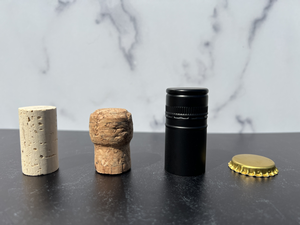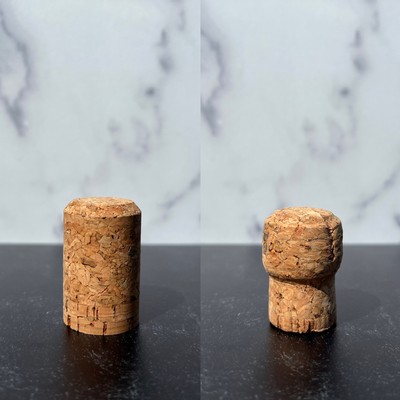Sealed with Style: Exploring the World of Wine Bottle Closures
Sealed with Style: Exploring the World of Wine Bottle Closures
 While we often marvel at the exquisite taste and aromas that wine has to offer, we often overlook the humble, yet, essential component that seals the precious liquid within the bottle. From traditional corks to modern screw caps and everything in between, the closure choice can have a significant impact on the aging process, preservation, and even the overall experience of enjoying a bottle of wine. Join us on this enlightening journey as we delve into the various types of wine bottle closures, exploring their history, advantages, and the ongoing debate surrounding their use. Whether you’re a wine enthusiast, a curious connoisseur, or simply someone looking to expand their knowledge, prepare to discover the secrets behind the different closures that bring our beloved wines to life.
While we often marvel at the exquisite taste and aromas that wine has to offer, we often overlook the humble, yet, essential component that seals the precious liquid within the bottle. From traditional corks to modern screw caps and everything in between, the closure choice can have a significant impact on the aging process, preservation, and even the overall experience of enjoying a bottle of wine. Join us on this enlightening journey as we delve into the various types of wine bottle closures, exploring their history, advantages, and the ongoing debate surrounding their use. Whether you’re a wine enthusiast, a curious connoisseur, or simply someone looking to expand their knowledge, prepare to discover the secrets behind the different closures that bring our beloved wines to life.
As you may know, the most common wine bottle closure is the cork. While there are many different corks - we will get into that in a little bit - there are several other alternative closures that are used in the world of wine. Those include screw caps, crown caps, vinoseal or vinolok, helix, and zork.
Since the beginning of modern Europe, corks have been the preferred choice for closing wine, Wine Folly explains. Cork bark is one of the few natural products that is malleable enough to hold the continents inside a glass bottle - which became more popular to store wine around the same time.
Before we get into the alternative closures, let’s look into the different versions of corks that can be used when sealing wine bottles.
Natural Corks
This commonly used cork is a renewable, recyclable, and biodegradable wine closure. Around 70% of all wines have been closed with cork seals in recent years. When it comes to fine wines, nearly 89% feature cork closures. The pros of using a natural cork are that they are a renewable resource, tradition, and cellar worthiness. The cons are that they are susceptible to taint, variability, fragility, and cost - depending on a number of factors, natural corks could cost up to three times more than screw caps.
Synthetic Corks
Yep, you guessed it. Synthetic corks are not made from natural cork but are still considered to be a cork. These cork-lookalikes can be made from either petroleum-based plastic or plant-based materials. Plastic corks are generally made from polyethylene - a malleable material that is melted down and turned into “foam” that imitates the porousness of natural cork. The pros of using a synthetic cork include consistency, durability, and affordability - synthetic corks can often be three times cheaper than natural corks. When it comes to the cons of synthetic corks, you can run into negative environmental impacts, difficulty opening and resealing the bottle, and a chemical odor.
Champagne/Sparkling Wine Cork
This type of cork differs from a traditional cork because of the cork disks at the bottom of it. The disc has more elasticity to help it expand when combined with the CO2 and six-to-eight bars of pressure in sparkling wine. This is what causes the mushroom-shaped cork we’re familiar with today.
(This image shows a chammpagne cork what it looks like before it goes into the bottle (left) and after (right)
Grainy (Agglomerate) Cork
Agglomerated corks are made from granulated cork dust that is bound together tightly by glue and pressure. These types of corks should only be used with wines that are destined to be consumed young because they tend to break down quicker. It is recommended that wines sealed with this type of cork should be consumed within six months of bottling.
Capped Cork
This type of cork combines both the benefits of a natural cork and plastic, with one part of each making up the bottle closure. Commonly, capped corks are used on beverages with high-alcohol percentages that are meant to be drunk in one sitting.
While there are many different corks, there are also many different types of alternative closures that can be used when sealing a wine bottle.
Screw Cap
The use of the screw cap on wine bottles started after Peter Wall, the former director of a South Australian winery, started to get fed up with tainted corks in circulation, explains Wine Enthusiast. After working with a French company, an aluminum cap, or the “Stelvin,” was invented. It wasn’t patented or used commercially until the late 1970s.
Over the next 40 years, the use of screw caps became a popular wine closure option for the majority of Australian and New Zealand producers.
These closures are usually made from aluminum with a neutral plastic liner on the inside to seal with the bottle. One big benefit of using screw caps is the little to no exposure of oxygen they provide. This is ideal for wines like Sauvignon Blanc. This option of alternative closure is not ideal for wines that are meant to age and develop over time.
Vinoseal
This is a recently introduced wine closure. Typically it is made from glass, which makes it a reusable and environmentally-friendly option. Just like screw caps, vinoseals create a near perfect oxygen barrier thanks to a rubber seal around the neck of the stopper. While they are pretty and environmentally-friendly, they are expensive and don’t do well in most bottling machines.
Crown Caps
Even though this type of closure is commonly found on beers and other similar beverages, it is a popular choice for sparkling wines in the world of wine. Before shipping, producers would replace the crown cap with a traditional champagne cork to preserve the fanfare of opening a bottle of bubbly. However, there are some producers that skip this step and just ship their product with the crowns on.
The world of wine closures offers a fascinating array of options, each with its unique advantages and drawbacks. From the traditional and time-tested cork to the convenience of screw caps and the eco-friendliness of synthetic corks, wine producers and consumers alike have a myriad of choices to consider. Embracing these diverse closures not only caters to varying preferences but also addresses environmental concerns and ensures the preservation of the precious liquid within. Ultimately, the choice of closure should align with the desired aging potential, style, and philosophy of each winemaker and cater to the taste preferences and expectations of every wine enthusiast.
As we continue to explore and innovate in the realm of wine closures, the symbiosis between tradition and modernity will undoubtedly yield a richer, more sustainable, and delightful wine experience for all. Cheers to the future of wine closures and the exciting possibilities they hold!
Comments
Commenting has been turned off.Recent Posts
-
August 21, 2025
-
August 9, 2025
-
July 1, 2025
-
June 3, 2025
-
May 2, 2025
-
April 9, 2025
-
March 6, 2025
-
February 11, 2025
-
January 10, 2025
-
December 12, 2024
